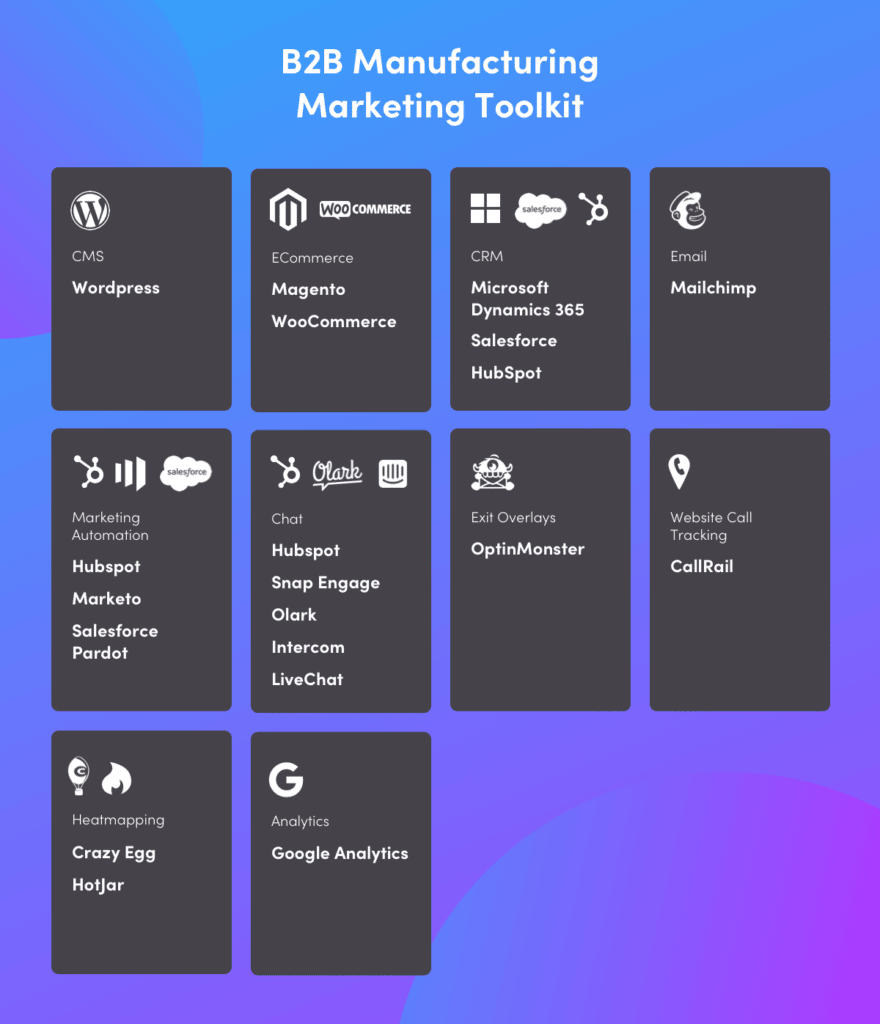
Buyers across every industry need information to make the best decisions, and according to Gartner B2B buyers spend the largest chunk of their buying time doing online research.
As your prospective clients are increasingly reliant on online research to help them determine which companies to work with, it’s essential to prioritize digital marketing in order to stay top of their minds.
Having worked closely with a number of manufacturing companies at Vital, we understand that you have unique challenges when it comes to attracting customers. Your marketing hastobe tailored to an intended audience that is often looking for specific, niche products—which means it has to be especially targeted.
That takes a lot of fine-tuning, which is why we’re sharing advice from our expert team about all the tools you need to build relationships with your clients.
About Vital
Vital has been building websites and crafting winning digital marketing strategies for over 20 years. A WP Engine Agency Partner, Vital has worked with hundreds of brands in diverse industries including , technology, higher education, and more to build online presences that help companies meet their business goals. Vital’s team of talented web and graphic designers, content strategists, branding professionals, and inbound marketers love sharing their knowledge about how to leverage WordPress to build sites that do more than just look good—they serve as the foundation for digital marketing with dramatic return on investment (ROI).
The following post was written by Vital Director of Digital Marketing Chris Getman,
The Importance of Digital Marketing for Manufacturers

Establishing and maintaining relationships in manufacturing sales will always be important, but your next generation of buyers is spending less time calling or traveling and more time Googling.
Millennials and Gen Z are “digital natives,” which means using online technology is second nature to them. As they continue to move into decision-making roles in business, the start of their B2B buyer’s journey will be entirely digital. In fact, research indicates that up to 70% of their journey is completed before the first contact with a salesperson.
Your best way forward is to make it as easy as possible for these buyers to conduct research and find what they’re looking for on your website pages, on your social media channels, and through any downloadable assets or on-demand videos.
That way, they’re able to educate themselves and make their own decisions—but in a way that enables you to control the message. And you need to be proactive, because if your digital presence isn’t telling the story of your value—be assured that your competitors are filling in that space.
What Manufacturers Need to Know About Digital Marketing

We could write an entire book about what you need to know about digital marketing (to be honest, we’ve already written several). Thinking about manufacturing specifically, there are a few high-level concepts that we can share with you—especially as these are things we walk through with all of our clients (as you’ll see).
Know how to build a digital marketing strategy.
You have to start somewhere, and taking the time to build a strategy will save you a lot of time, a lot of money, and a lot of headaches. It’s important to understand that this is a large undertaking that will take time to execute properly, though if we had to summarize the process, here are the fundamentals:
- Establish what your marketing goals are, whether they’re qualitative or quantitative in nature, and how you’ll measure success.
- Understand how to tell your unique story of value, so that you’re communicating benefits to your customers.
- Build a website that works for you and your customers by ensuring that it is easy to navigate, easy to update, scalable, flexible, and secure.
- Coordinate a conversion rate optimization (CRO) strategy, a paid digital advertising strategy, an email marketing strategy, and a content marketing strategy to increase your reach to customers, gain their attention, and nurture leads.
When American Modular Systems (AMS) needed to consolidate two underperforming websites, we realized we had a great opportunity to start fresh and develop a strategy that would help them in multiple areas.
By creating one new website, we could highlight AMS’ brand equity, better define their product lines, and engage their prospective buyers. We built out a robust set of pages to position AMS as a thought leader, educate users about their product lines, help clients identify the best solution for their project, and optimize their SEO value in the process.

Know what information is valuable to your audience.
So, you’ve developed a strategy to get your information out to prospective clients—but do you know exactly what you need to tell them? Having worked with multiple clients, we know that B2B industrial buyers want to see technical specifications, detailed product descriptions, and specific benefits in the form of ROI and other metrics.
When they search, these buyers are looking for things like SKU numbers, industries, materials, tolerances, and other specifications. That information not only has to be relevant to your clients, but it also has to be easy for them to navigate.
Ortholite already had great relationships with the major shoe brands it provides insoles to. But, they needed an easier way to update their online sales collateral to make it more searchable.
We applied an eCommerce logic to their website’s browsing experience, so even though purchases aren’t actually made online, sales reps can navigate the website as an inherently easy-to-use web store to find the information they need.
Know how to actually reach your audience.
Having relevant information is great, but that’s only if you’re consistently showing up on the first page of search results for those keywords and search terms relevant to your industry. You need a successful SEO strategy to boost your manufacturing company’s website search engine rankings, thereby making your company more visible to a larger audience.
Otherwise, prospective customers looking to purchase your products will not just have a harder time finding you, they’re likely to find your competitors first. Ranking high on SERPs also positions you as a leader in the market, which will lead to growth and brand equity that drives value beyond just search traffic and direct leads.
One way to boost your position on SERPs and drive more traffic to your website is to create individual parts pages that target specific keywords. That is what we did for torque wrench manufacturer GWY to increase their chances of showing up in product specific-searches and boost their overall technical SEO.
As a result, the company now consistently ranks high on SERPs related to their specific products.

Know how to convert your audience into customers.
Getting your content to your audience is crucial, but that also reminds us about the old adage of leading a horse to water—you need a way to get your audience to be more than browsers, and to convert into a customer, they’ll need to be active and engage on your website—even if it’s something as simple as a contact form.
So how do you make them drink? Give them something to engage with. Promote assets like ebooks, webinars, newsletters, and whitepapers through direct contact from emails, exit overlays, pop-up CTAs, and chatbots.
As Texture Plus saw more competition entering the field of faux wall panels, they knew they had to be more efficient in converting leads. We took a multi-pronged approach that included a full analysis to determine the best path to conversion for the many customer types that visited their page.
From there, we developed content and assets to drive conversion—part of which included targeted email campaigns to introduce Texture Plus’ new products and promotions in a manner that created excitement and encouraged clients to act. The results saw an increase in content download leads, the growth of their email subscribers, and increased eCommerce sales.
Know which tools to use for your digital marketing strategy.
As a manufacturer, you understand more than most that, to be successful, you need the right tools for the job. The same is true for digital marketing—the best strategies and content in the world wide web aren’t going to do you any good if you’re struggling with getting things to work or are lacking essential functions. Or worse, paying for features you don’t need or leaving yourself open to vulnerabilities.
There are a lot of tools out there, and finding the right ones can either help your digital marketing or hinder it.
Leading compact equipment manufacturer Bobcat has enjoyed great success and international recognition due to its digital marketing efforts. Even better, the company continues to be in a position to claim large segments of the compact equipment industry’s market share. That’s because Bobcat uses some of the industry’s leading software technologies to build and maintain its website’s foundation and digital marketing strategy structure, including WordPress, Google Analytics, and Pardot.
10 Digital Marketing Tools that Manufacturers Need

So, exactly which digital marketing tools should you be looking into? Here’s our overview of the software solutions and platforms that every manufacturer should have in their digital marketing toolkit.
1. Content Management System (CMS)
A CMS is an online platform that enables you to design and build websites either using pre-made themes or custom designs. We’re pretty partial to WordPress, and we use it for almost all of our client sites.
2. eCommerce Platform
An eCommerce platform is a software application that supplies the client-facing component of an online business. eCommerce platforms enable businesses to manage online sales, marketing, and operations. We’re fond of Magento as it’s the most popular eCommerce platform on the market today, powering well over 250,000 merchants (plus, we’re an official partner). WooCommerce is also a great option if you’re looking for a flexible, open source solution to build an eCommerce platform—plus WP Engine’s WooCommerce hosting is optimized to increase site speed and drive conversions.
3. Customer Relationship Management (CRM) Tool
A CRM is a software system that enables businesses to gather and analyze customer data to improve customer service, sales, and marketing efforts. For solutions, you can’t go wrong with Microsoft Dynamics 365, Salesforce, or HubSpot.
4. Email Marketing Platform
Email marketing software is designed to help businesses plan, execute, automate, and monitor the success of email marketing campaigns. In our view, MailChimp is the best email marketing software in the business.
5. Marketing Automation
Marketing automation basically refers to a software system designed to make it easier for businesses to streamline repetitive tasks and market across multiple channels at the same time. For B2B companies, we recommend Marketo, Pardo, and Hubspot as platforms of choice.
6. Live or AI Chat
A live chat is a module that appears on a website—generally in the bottom right-hand corner — that enables visitors to interact with live customer service representatives in real time. If your company doesn’t have the capacity to staff live chat, an AI chatbot gives your customers another way to interact, cutting down on response time and reducing friction. For chatbot functionality, look into SnapEngage and HubSpot. For live chat, we recommend Olark, Intercom, and LiveChat.
7. Exit Overlays
Also known as an exit-intent overlay, an exit overlay is a pop-up that appears just as a site visitor is about to close the page. Exit overlays typically advertise some sort of special offer or discount to recapture the visitor’s interest and lure them back in. There’s only one clear choice for us, and it’s OptinMonster.
8. Website Call Tracking
Website call tracking enables businesses to trace the origin of phone leads by inserting a tracking number into paid ads, emails, landing pages, and more. We really like CallRail as it allows for both source-level and keyword-level tracking.
9. Google Analytics
Google Analytics is Google’s free web analytics tool that tracks and reports website traffic. It is the most widely used web analytics service in the world — so there’s really no other option.
10. Heat Mapping
Heat mapping is a data visualization technique that enables businesses to track the actual time visitors spend interacting with various elements of their website using a warm-to-cool color spectrum. You can consider Crazy Egg for combination heat mapping and A/B testing, but we also recommend Hotjar as a free alternative.
So, those are our recommended steps and tools to utilize in your digital marketing. But trust us, there’s a LOT more to the process and using the tools efficiently. Thankfully, we enjoy that kind of challenge. Learn more about working with Vital, and speak with a representative to find out more about WP Engine’s plans and pricing.
About the Author
Chris Getman is responsible for the strategy and execution of digital marketing tactics for diverse client roster. Over the years, Chris has consulted on digital marketing strategies for some of the biggest brands in the world. He has been a featured speaker at marketing conferences and events such as the University of New Hampshire’s Digital Marketing Symposium, , and . Additionally, Chris has been featured as a guest speaker in multiple marketing classes at the University of New Hampshire. Chris has also contributed as a guest writer on some of the top marketing websites around, including and . He holds multiple certifications from HubSpot and Google and graduated from the .

Leave a Reply